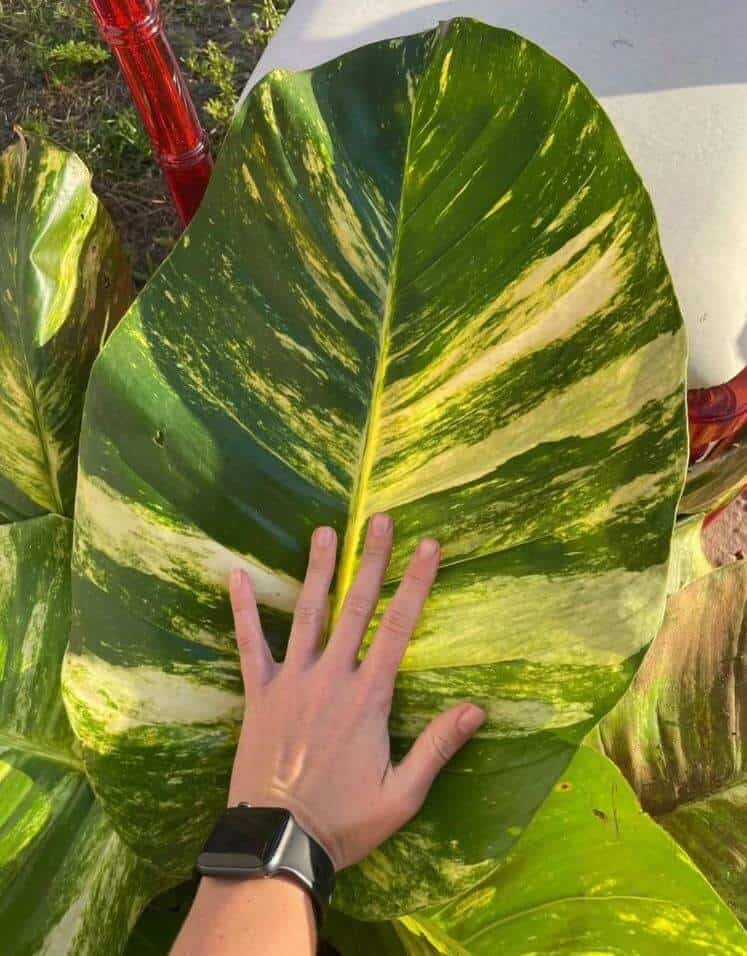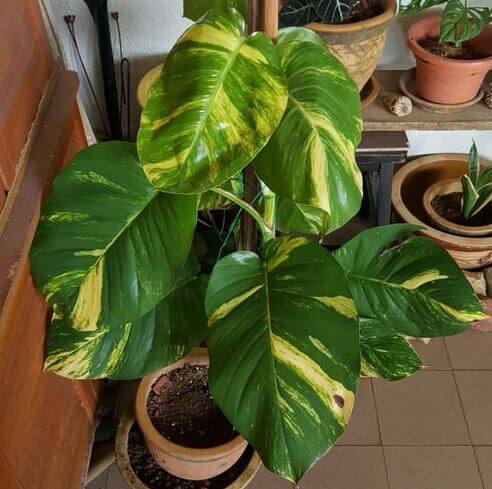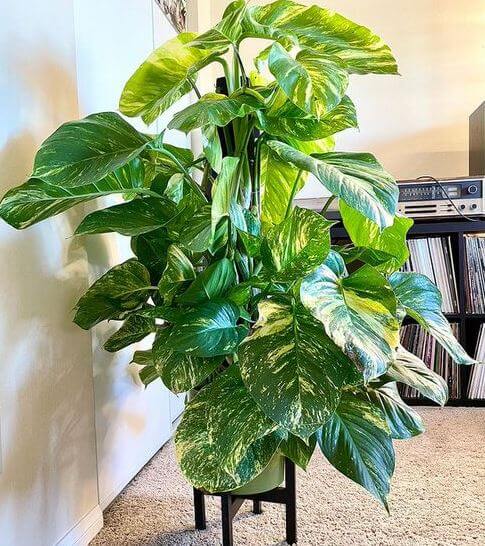Last Updated on January 5, 2023 by a Friendly Gardener
If you like the dependable and hardy Pothos plant, you’ll love the Giant Pothos plant! A giant pothos appears to be a Golden Pothos only much larger. These plants should not be confused, however, because your standard pothos plant will never grow to be as large as a giant pothos.
The giant pothos is exactly what the name implies: giant. These are variegated plants with foliage that boasts golden streaks and that can eventually fenestrate or split much as the monstera does. Again, they do differentiate themselves from the monstera in that they are variegated and will only split leaves if they are huge. A pothos will also maintain an oval-shaped leaf whereas a monstera has a more unique shape when it comes to foliage.
Botanically known as the Epipremnum Pinnatum or the Epipremnum Aureum, it is commonly referred to as a
- Giant Pothos
- Giant Golden Pothos
- Monstera Pothos
- Hawaiian Golden Pothos
- Devil’s Ivy
- Money Plant
and even a few other names. It belongs to the Araceae family and finds its natural habitat in Southeast Asia. A giant pothos is a striking plant to host in a home garden.
Giant Pothos Plant Care

The plants of this particular genus are usually quite easy to care for and a favorite for those without a green thumb or with limited time to dedicate to plant grooming. These plants are known to be hardy but will nonetheless require some basic care.
Soil
For Giant Pothos plant indoor cultivation, you need light loose soil when container grown. The potting mix should drain well yet retain some moisture. Blending a soil mix with equal parts of peat moss, potting soil, and perlite is ideal. The perlite will aid with drainage because soggy soil will damage roots. Soil pH should be neutral to slightly acidic and measure between 5.5 and 7.
Light

Pothos plants do best when guaranteed bright indirect natural light. With sufficient light exposure, your giant pothos will grow faster and foliage will be vibrant. A pothos plant should not be placed in direct sunlight as this will damage leaves. They can tolerate low light conditions, especially if leaves have a darker green hue.
Water
When watering a Giant Pothos, check your plant’s soil bed weekly. When approximately 30% to 40% is dry, it’s time for a drink. This is a forgiving plant, so a bit of underwatering or overwatering should not place it in harm’s way. If the foliage begins to droop, you’ll know your plant is thirsty. Use distilled water of collected rainwater to avoid salts found in tap water from building up on leaves.
Humidity
The ideal level for indoor humidity is around 50% for this plant. They will also respond well to the occasional misting. Tips of leaves may turn brown if the humidity is too low. Kitchens and bathrooms will have moister environmental air.
Temperature
The Giant Pothos is not a fussy plant so average indoor temperatures should be fine. Ideally, your room temps should be in the range of 65° to 75° F.
Feeding

Fertilizing a Giant Pothos is not required, but you’ll definitely boost the plant’s growth if you do feed it on occasion. Use a standard liquid 20-20-20 fertilizer formulated for leafy plants and dilute it to half-strength. Apply it once monthly during the spring and summer seasons. Fall and winter are the plant’s rest periods, so avoid fertilizing.
Pruning
Pruning occasionally will help your plant stay in shape. Always remove dead and damaged leaves by cutting above a leaf node. Pruning is recommended at the beginning of spring or in the fall. Do not prune when this plant is actively growing and never remove more than one-third of the foliage at pruning time.
Potting and Repotting a Giant Pothos Plant

When a Pothos becomes root bound, it’s time to repot. You’ll know because roots will peak through drainage holes. It is a good practice to plan on repotting annually at the beginning of spring so that the soil bed has sufficient nutrients to keep your plant healthy and happy. When repotting choose a new container that is no more than two inches larger.
A Giant Pothos will also do well with some support, so the addition of a trellis or moss pole is recommended. This will help your plant in its climbing and stimulate larger foliage growth resulting in fenestration.
Giant Pothos Propagation

Any Pothos plant can be propagated using stem cuttings, but due to the Giant Pothos’ size plan on propagating by transferring a stem cutting directly into a pot of soil mix. Select a stem cutting with a least a pair of leaves and a leaf node. Place the cutting directly in a fresh planter of soil and water it evenly.
The cutting should be placed in a warm location with lots of indirect light and good humidity. The soil needs to be kept moist. Expect your cutting to develop roots within a month to two months’ time.
If you are concerned about humidity levels, place a plastic bag over the pot in a loose manner. Good humidity will encourage the cutting’s rooting. Your cutting will probably need several months to root completely before you notice new growth.
Giant Pothos Plant Problems
This plant will show any problems it’s having with its foliage. Leaves may turn yellow, and this is generally due to a watering issue, either too little or too much. If allowed to continue, leaves may even turn brown and then drop from your plant. Diseases due to watering issues may include Bacterial Leaf Spots and root rot.
Pests are not common but keep an eye out for common houseplant pests like scales and mealybugs as well as spider mites and aphids. Opt for a non-toxic solution like insecticidal soap or organic Neem oil.
Too much light may cause variegation to fade. Crispy brown edges may indicate cool drafts. Reposition your plant in either of these cases.
Giant Pothos Toxicity
The Giant Pothos is toxic to family pets due to calcium oxalate crystals present in all of its parts. This substance may cause vomiting if chewed or ingested. Talk to your veterinarian if you suspect your dog or cat has eaten your Giant Pothos.
A Giant Pothos Plant or Giant Golden Pothos Plant?
While young, these plants do resemble each other, but with maturity, two principal differences will develop. A Giant Pothos plant is considerably larger than a Golden Pothos plant and its leaves are bigger as well, and a Giant Pothos may develop leaf fenestrations that resemble a Monstera, whereas a Golden Pothos plant will not. So, if your plant is quite large with big foliage that develops fenestrations, you have a Giant Pothos plant and not a Golden Pothos plant.

